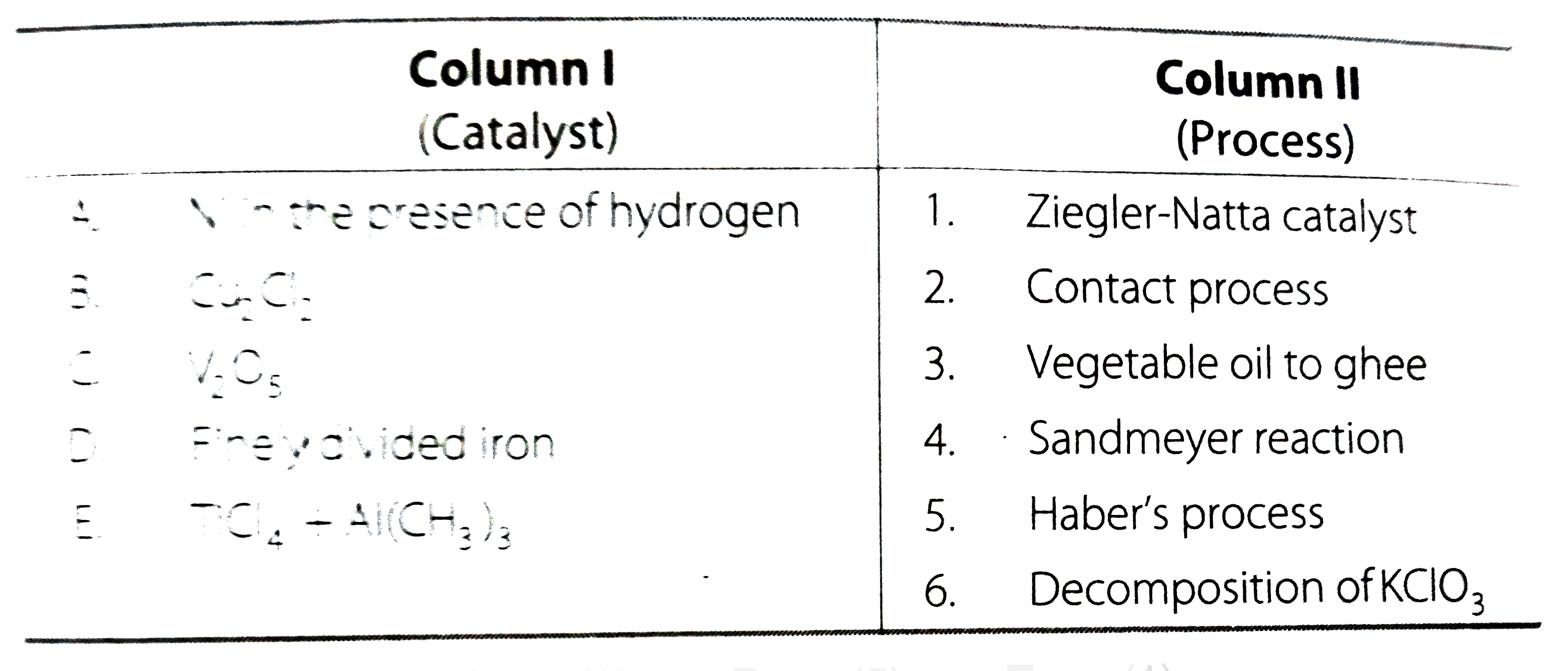Match the catalysts to the correct processes :
The correct Answer is:A
To solve the problem of matching the catalysts to their respective processes, we will analyze each catalyst and process step by step.
Step 1: Identify the catalysts and their corresponding processes
1. Catalysts:
- A: TiCl₃
- B: PdCl₂
- C: CuCl₂
- D: V₂O₅
2. Processes:
- (i) Wacker process
- (ii) Ziegler-Natta polymerization
- (iii) Contact process
- (iv) Deacon's process
Step 2: Analyze each process and identify the correct catalyst
1. Wacker Process:
- The Wacker process involves the oxidation of alkenes to aldehydes using palladium chloride (PdCl₂) as a catalyst.
- Match: B (PdCl₂) with (i) Wacker process.
2. Ziegler-Natta Polymerization:
- This process is used for the polymerization of alkenes, specifically ethylene, and utilizes titanium chloride (TiCl₃) as a catalyst.
- Match: A (TiCl₃) with (ii) Ziegler-Natta polymerization.
3. Contact Process:
- The Contact process is used for the production of sulfuric acid (H₂SO₄) and involves the oxidation of sulfur dioxide (SO₂) to sulfur trioxide (SO₃) using vanadium pentoxide (V₂O₅) as a catalyst.
- Match: D (V₂O₅) with (iii) Contact process.
4. Deacon's Process:
- Deacon's process is used for the oxidation of hydrogen chloride (HCl) to chlorine (Cl₂) and commonly uses copper(II) chloride (CuCl₂) as a catalyst.
- Match: C (CuCl₂) with (iv) Deacon's process.
Step 3: Summarize the matches
- A (TiCl₃) → (ii) Ziegler-Natta polymerization
- B (PdCl₂) → (i) Wacker process
- C (CuCl₂) → (iv) Deacon's process
- D (V₂O₅) → (iii) Contact process
Final Matching
- A → ii
- B → i
- C → iv
- D → iii
Conclusion
The correct matches are:
- A → ii (Ziegler-Natta polymerization)
- B → i (Wacker process)
- C → iv (Deacon's process)
- D → iii (Contact process)
Answer Format
The final order is:
- A2
- B1
- C4
- D3
Thus, the correct option is Option 1.
---
- A: TiCl₃
- B: PdCl₂
- C: CuCl₂
- D: V₂O₅
- (i) Wacker process
- (ii) Ziegler-Natta polymerization
- (iii) Contact process
- (iv) Deacon's process
- The Wacker process involves the oxidation of alkenes to aldehydes using palladium chloride (PdCl₂) as a catalyst.
- Match: B (PdCl₂) with (i) Wacker process.
- This process is used for the polymerization of alkenes, specifically ethylene, and utilizes titanium chloride (TiCl₃) as a catalyst.
- Match: A (TiCl₃) with (ii) Ziegler-Natta polymerization.
- The Contact process is used for the production of sulfuric acid (H₂SO₄) and involves the oxidation of sulfur dioxide (SO₂) to sulfur trioxide (SO₃) using vanadium pentoxide (V₂O₅) as a catalyst.
- Match: D (V₂O₅) with (iii) Contact process.
- Deacon's process is used for the oxidation of hydrogen chloride (HCl) to chlorine (Cl₂) and commonly uses copper(II) chloride (CuCl₂) as a catalyst.
- Match: C (CuCl₂) with (iv) Deacon's process.
- B (PdCl₂) → (i) Wacker process
- C (CuCl₂) → (iv) Deacon's process
- D (V₂O₅) → (iii) Contact process
- B → i
- C → iv
- D → iii
- A → ii (Ziegler-Natta polymerization)
- B → i (Wacker process)
- C → iv (Deacon's process)
- D → iii (Contact process)
- A2
- B1
- C4
- D3
Topper's Solved these Questions
Similar Questions
For the process, H2O(l)→H2O(g)
View SolutionMatch the catalyst given in Column I with the processes given in Column II.

View SolutionMatch List -I (substances) with List -II (processes) employed in the manufacture of the substances and select the correct option.
List -IList -IISubstancesProcesses(a)Sulphuric acid(i)Haber's Process(b)Steel(ii)Bessemer's Process(c)Sodium hydroxide(iii)Leblanc Process(d)Ammonia(iv)contact Process
View SolutionMatch the following:
(a)pure nitrogen(i) chlorine(b) Haber process(ii) Sulphuric acid(c) Contact process(iii) Ammonia(d) deacon's process(iv) Sodium azide or Barium azide
View SolutionMatch the cataysts (Column I) with products (Column II).
Column IColumn IICatalystProduct(A)V2O5(i)Polyethylene(B)TiCl4/Al(Me)3(ii)ethanal(C)PdCl2(iii)H2SO4(D)Iron Oxide(iv)NH3
View SolutionDescribe the manufacture of H2SO4 by contact process?
View SolutionMatch the lists and the correct option
III(a)Mastoid process1.Premaxilla(b)Acromion process2.Axis(c)Olecranon process3.Scapula(d)Odontoid process4.Ulna5.Periotic bone
View SolutionMatch column A (catalyst) with column B (process)
Column A Column B1.SO2i.Cracking of hydrocarbons2.Ptii.Alkylation of benzene3.Zeolitesiii.Automobile converter
View SolutionChoose the correct answer from the options given below: The catalyst used in the Contact Process is :
View SolutionIn the manufacture of H2SO4 by contact process, the presence of As2O3 acts as :-
View Solution
